Effects of Wire Electrical Discharge Finishing Cuts on the Surface Integrity of Additively Manufactured Ti6Al4V Alloy
Abstract
:1. Introduction
2. Materials and Methods
3. Results and Discussions
3.1. Surface Surface Morphology Properties Analyses
3.2. Surface Topography Properties Analyses
3.3. Surface Layer Composition Analyses
4. Conclusions
- The use of finishing WEDM cuts decreases the typical defects of SLM surface integrity, such as balling effects and microcracks. In the case of using four finishing passes, the occurrence of microcracks was eliminated;
- When using four finishing passes, the smallest volume of material was removed in the last pass, which was achieved by reversing the polarity of the electrodes. This led to the least amount of thermal energy being supplied to the material, resulting in a smaller volume of material being removed and re-solidified on the surface. The reversal of polarization also reduced the temperature gradient applied to the material, which may have contributed to lower tensile residual stresses, a key cause of microcracking;
- A significant improvement in the surface topography parameters Sa, Spk, Svk, and Sk results directly from the number of finishing WEDM cuts and discharge energy. The maximal improvement of parameters Sa, Spk, Svk, and Sk was about 88% for using four finishing WEDM cuts and the lowest discharge energy delivered to the workpiece by using the reverse polarity;
- The thermal effects of discharges cause the change in surface morphology. The composition and thickness of the recast layer depend on the discharge energy and the number of finishing cuts. Reduced discharge energy leads to a decrease in the transfer of elements from the working electrode to the workpiece surface layer. The change in composition of surface layers was observed in the depth range of 2 to 10 µm;
- The polarity of the electrode has a significant influence on the composition of the recast layer. The highest value of transfer zinc and copper (about 21% of mass) was observed for using reverse polarity in fourth trim cuts. However, the depth of composition change does not exceed 2 µm;
- Further tests should be undertaken to establish the relationship between the electrical discharge energy, the volume of material removed and re-solidified, and the induced tensile stress.
Author Contributions
Funding
Institutional Review Board Statement
Informed Consent Statement
Data Availability Statement
Conflicts of Interest
References
- Gupta, M.K.; Etri, H.E.; Korkmaz, M.E.; Ross, N.S.; Krolczyk, G.M.; Gawlik, J.; Yaşar, N.; Pimenov, D.Y. Tribological and Surface Morphological Characteristics of Titanium Alloys: A Review. Archiv. Civ. Mech. Eng. 2022, 22, 72. [Google Scholar] [CrossRef]
- Gupta, M.K.; Niesłony, P.; Korkmaz, M.E.; Kuntoğlu, M.; Królczyk, G.M.; Günay, M.; Sarikaya, M. Comparison of Tool Wear, Surface Morphology, Specific Cutting Energy and Cutting Temperature in Machining of Titanium Alloys Under Hybrid and Green Cooling Strategies. Int. J. Precis. Eng. Manuf.-Green Tech. 2023, 10, 1–14. [Google Scholar] [CrossRef]
- Liu, Y.; Geng, D.; Zhang, D.; Zhai, Y.; Liu, L.; Sun, Z.; Shao, Z.; Zhang, M.; Jiang, X. Cutting Performance and Surface Integrity for Rotary Ultrasonic Elliptical Milling of Inconel 718 with the Ball End Milling Cutter. J. Mater. Process. Technol. 2023, 319, 118094. [Google Scholar] [CrossRef]
- Liu, Y.; Zhang, D.; Geng, D.; Shao, Z.; Zhou, Z.; Sun, Z.; Jiang, Y.; Jiang, X. Ironing Effect on Surface Integrity and Fatigue Behavior during Ultrasonic Peening Drilling of Ti-6Al-4V. Chin. J. Aeronaut. 2023, 36, 486–498. [Google Scholar] [CrossRef]
- Armstrong, M.; Mehrabi, H.; Naveed, N. An Overview of Modern Metal Additive Manufacturing Technology. J. Manuf. Process. 2022, 84, 1001–1029. [Google Scholar] [CrossRef]
- Shi, Q.; Gu, D.; Xia, M.; Cao, S.; Rong, T. Effects of Laser Processing Parameters on Thermal Behavior and Melting/Solidification Mechanism during Selective Laser Melting of TiC/Inconel 718 Composites. Opt. Laser Technol. 2016, 84, 9–22. [Google Scholar] [CrossRef]
- Hossain, M.S.; Baniasadi, M.; Taheri, H. Material Characterisation of Additive Manufacturing Titanium Alloy (Titanium 6Al-4V) for Quality Control and Properties Evaluations. Adv. Mater. Process. Technol. 2022, 8, 4678–4697. [Google Scholar] [CrossRef]
- Zhou, R.; Liu, H.; Wang, H. Modeling and Simulation of Metal Selective Laser Melting Process: A Critical Review. Int. J. Adv. Manuf. Technol. 2022, 121, 5693–5706. [Google Scholar] [CrossRef]
- Serjouei, A.; Libura, T.; Brodecki, A.; Radziejewska, J.; Broniszewska, P.; Pawłowski, P.; Szymczak, T.; Bodaghi, M.; Kowalewski, Z.L. Strength-Hardness Relationship for AlSi10Mg Alloy Produced by Laser Powder Bed Fusion: An Experimental Study. Mater. Sci. Eng. A 2022, 861, 144345. [Google Scholar] [CrossRef]
- Wang, Z.; Xiao, Z.; Tse, Y.; Huang, C.; Zhang, W. Optimization of Processing Parameters and Establishment of a Relationship between Microstructure and Mechanical Properties of SLM Titanium Alloy. Opt. Laser Technol. 2019, 112, 159–167. [Google Scholar] [CrossRef]
- Costa, A.; Buffa, G.; Palmeri, D.; Pollara, G.; Fratini, L. Hybrid Prediction-Optimization Approaches for Maximizing Parts Density in SLM of Ti6Al4V Titanium Alloy. J. Intell. Manuf. 2022, 33, 1967–1989. [Google Scholar] [CrossRef]
- Bertocco, A.; Iannitti, G.; Caraviello, A.; Esposito, L. Lattice Structures in Stainless Steel 17-4PH Manufactured via Selective Laser Melting (SLM) Process: Dimensional Accuracy, Satellites Formation, Compressive Response and Printing Parameters Optimization. Int. J. Adv. Manuf. Technol. 2022, 120, 4935–4949. [Google Scholar] [CrossRef]
- Franczyk, E.; Machno, M.; Zębala, W. Investigation and Optimization of the SLM and WEDM Processes’ Parameters for the AlSi10Mg-Sintered Part. Materials 2021, 14, 410. [Google Scholar] [CrossRef]
- Blakey-Milner, B.; Gradl, P.; Snedden, G.; Brooks, M.; Pitot, J.; Lopez, E.; Leary, M.; Berto, F.; du Plessis, A. Metal Additive Manufacturing in Aerospace: A Review. Mater. Des. 2021, 209, 110008. [Google Scholar] [CrossRef]
- Ron, T.; Shirizly, A.; Aghion, E. Additive Manufacturing Technologies of High Entropy Alloys (HEA): Review and Prospects. Materials 2023, 16, 2454. [Google Scholar] [CrossRef]
- Kozak, J.; Zakrzewski, T. Accuracy Problems of Additive Manufacturing Using SLS/SLM Processes. AIP Conf. Proc. 2018, 2017, 020010. [Google Scholar] [CrossRef]
- Li, R.; Jin, M.; Paquit, V.C. Geometrical Defect Detection for Additive Manufacturing with Machine Learning Models. Mater. Des. 2021, 206, 109726. [Google Scholar] [CrossRef]
- Nguyen, H.D.; Pramanik, A.; Basak, A.K.; Dong, Y.; Prakash, C.; Debnath, S.; Shankar, S.; Jawahir, I.S.; Dixit, S.; Buddhi, D. A Critical Review on Additive Manufacturing of Ti-6Al-4V Alloy: Microstructure and Mechanical Properties. J. Mater. Res. Technol. 2022, 18, 4641–4661. [Google Scholar] [CrossRef]
- Zhou, X.; Liu, X.; Zhang, D.; Shen, Z.; Liu, W. Balling Phenomena in Selective Laser Melted Tungsten. J. Mater. Process. Technol. 2015, 222, 33–42. [Google Scholar] [CrossRef]
- Wang, L.; Li, E.L.; Shen, H.; Zou, R.P.; Yu, A.B.; Zhou, Z.Y. Adhesion Effects on Spreading of Metal Powders in Selective Laser Melting. Powder Technol. 2020, 363, 602–610. [Google Scholar] [CrossRef]
- Wang, Z.; Yang, S.; Huang, Y.; Fan, C.; Peng, Z.; Gao, Z. Microstructure and Fatigue Damage of 316L Stainless Steel Manufactured by Selective Laser Melting (SLM). Materials 2021, 14, 7544. [Google Scholar] [CrossRef] [PubMed]
- Xue, J.; Feng, Z.; Tang, J.; Tang, C.; Zhao, Z. Selective Laser Melting Additive Manufacturing of Tungsten with Niobium Alloying: Microstructure and Suppression Mechanism of Microcracks. J. Alloys Compd. 2021, 874, 159879. [Google Scholar] [CrossRef]
- Ye, C.; Zhang, C.; Zhao, J.; Dong, Y. Effects of Post-Processing on the Surface Finish, Porosity, Residual Stresses, and Fatigue Performance of Additive Manufactured Metals: A Review. J. Mater. Eng. Perform. 2021, 30, 6407–6425. [Google Scholar] [CrossRef] [PubMed]
- Oyelola, O.; Crawforth, P.; M’Saoubi, R.; Clare, A.T. On the Machinability of Directed Energy Deposited Ti6Al4V. Addit. Manuf. 2018, 19, 39–50. [Google Scholar] [CrossRef]
- Karakılınç, U.; Ergene, B.; Yalçın, B.; Aslantaş, K.; Erçetin, A. Comparative Analysis of Minimum Chip Thickness, Surface Quality and Burr Formation in Micro-Milling of Wrought and Selective Laser Melted Ti64. Micromachines 2023, 14, 1160. [Google Scholar] [CrossRef]
- Tan, R.; Zhao, X.; Liu, Q.; Guo, X.; Lin, F.; Yang, L.; Sun, T. Investigation of Surface Integrity of Selective Laser Melting Additively Manufactured AlSi10Mg Alloy under Ultrasonic Elliptical Vibration-Assisted Ultra-Precision Cutting. Materials 2022, 15, 8910. [Google Scholar] [CrossRef]
- Obeidi, M.A.; Mussatto, A.; Dogu, M.N.; Sreenilayam, S.P.; McCarthy, E.; Ahad, I.U.; Keaveney, S.; Brabazon, D. Laser Surface Polishing of Ti-6Al-4V Parts Manufactured by Laser Powder Bed Fusion. Surf. Coat. Technol. 2022, 434, 128179. [Google Scholar] [CrossRef]
- Teimouri, R.; Sohrabpoor, H.; Grabowski, M.; Wyszyński, D.; Skoczypiec, S.; Raghavendra, R. Simulation of Surface Roughness Evolution of Additively Manufactured Material Fabricated by Laser Powder Bed Fusion and Post-Processed by Burnishing. J. Manuf. Process. 2022, 84, 10–27. [Google Scholar] [CrossRef]
- Sun, Y.; Bailey, R.; Moroz, A. Surface Finish and Properties Enhancement of Selective Laser Melted 316L Stainless Steel by Surface Mechanical Attrition Treatment. Surf. Coat. Technol. 2019, 378, 124993. [Google Scholar] [CrossRef]
- Han, S.; Salvatore, F.; Rech, J.; Bajolet, J. Abrasive Flow Machining (AFM) Finishing of Conformal Cooling Channels Created by Selective Laser Melting (SLM). Precis. Eng. 2020, 64, 20–33. [Google Scholar] [CrossRef]
- Davoodi, F.; Taghian, M.; Carbone, G.; Saboori, A.; Iuliano, L. An Overview of the Latest Progress in Internal Surface Finishing of the Additively Manufactured Metallic Components. Materials 2023, 16, 3867. [Google Scholar] [CrossRef]
- Xu, L.-Y.; Xi, X.-C.; Zhang, Y.-O.; Li, Z.-L.; Ma, J.-Y.; Gao, Q.; Zhao, W.-S. Online Workpiece Height Estimation Method Based on Discharge Location Detection for Reciprocated Traveling WEDM. J. Manuf. Syst. 2022, 65, 317–329. [Google Scholar] [CrossRef]
- Nieslony, P.; Wojciechowski, S.; Gupta, M.K.; Chudy, R.; Krolczyk, J.B.; Maruda, R.; Krolczyk, G.M. Relationship between Energy Consumption and Surface Integrity Aspects in Electrical Discharge Machining of Hot Work Die Steel. Sustain. Mater. Technol. 2023, 36, e00623. [Google Scholar] [CrossRef]
- Świercz, R.; Oniszczuk-Świercz, D.; Zawora, J.; Marczak, M. Investigation of the Influence of Process Parameters on Shape Deviation after Wire Electrical Discharge Machining. Arch. Metall. Mater. 2019, 64, 1457–1462. [Google Scholar] [CrossRef]
- Burek, J.; Babiarz, R.; Buk, J.; Sułkowicz, P.; Krupa, K. The Accuracy of Finishing WEDM of Inconel 718 Turbine Disc Fir Tree Slots. Materials 2021, 14, 562. [Google Scholar] [CrossRef]
- Sharma, P.; Chakradhar, D.; Narendranath, S. Precision Manufacturing of Turbine Wheel Slots by Trim-Offset Approach of WEDM. Precis. Eng. 2021, 71, 293–303. [Google Scholar] [CrossRef]
- Jithin, S.; Joshi, S.S. Surface Topography Generation and Simulation in Electrical Discharge Texturing: A Review. J. Mater. Process. Technol. 2021, 298, 117297. [Google Scholar] [CrossRef]
- Gołąbczak, M.; Święcik, R.; Gołąbczak, A.; Kaczmarek, D.; Dębkowski, R.; Tomczyk, B. Electrodischarge Methods of Shaping the Cutting Ability of Superhard Grinding Wheels. Materials 2021, 14, 6773. [Google Scholar] [CrossRef] [PubMed]
- Straka, Ľ.; Gombár, M.; Vagaská, A.; Kuchta, P. Efficiency Optimization of the Electroerosive Process in Μ-WEDM of Steel MS1 Sintered Using DMLS Technology. Micromachines 2022, 13, 1446. [Google Scholar] [CrossRef] [PubMed]
- Venkatarao, K.; Reddy, M.C.; Kumar, Y.P.; Raju, L.S.; Rao, B.R.; Azad, D. Multi-Response Optimization in WEDM Process of Al–Si Alloy Using TLBO-Graph Theory Algorithm towards Sustainability. Int. J. Adv. Manuf. Technol. 2023, 126, 3679–3694. [Google Scholar] [CrossRef]
- Vagaská, A.; Gombár, M.; Straka, Ľ. Selected Mathematical Optimization Methods for Solving Problems of Engineering Practice. Energies 2022, 15, 2205. [Google Scholar] [CrossRef]
- Straka, L.; Krenicky, T. Geometric Precision of the Cylinders Surfaces Machined with WEDM Technology. MM Sci. J. 2022, 2022, 6200–6204. [Google Scholar] [CrossRef]
- Wang, J.; Sánchez, J.A.; Izquierdo, B.; Ayesta, I. Effect of Discharge Accumulation on Wire Breakage in WEDM Process. Int. J. Adv. Manuf. Technol. 2023, 125, 1343–1353. [Google Scholar] [CrossRef]
- Xu, L.-Y.; Xi, X.-C.; Li, Z.-L.; Ma, J.-Y.; Gao, Q.; Zhao, W.-S. Wire Breakage Prevention for Reciprocated Traveling WEDM Based on Discharge Location Detection. Int. J. Adv. Manuf. Technol. 2022, 123, 1859–1875. [Google Scholar] [CrossRef]
- Song, K.Y.; Kim, G.H.; Shin, J. A Hybrid Manufacturing Process for a Microgripper Using Selective Laser Melting 3D Printing and Wire EDM. J. Mech. Sci. Technol. 2023, 37, 1931–1937. [Google Scholar] [CrossRef]
- Boban, J.; Ahmed, A. Improving the Surface Integrity and Mechanical Properties of Additive Manufactured Stainless Steel Components by Wire Electrical Discharge Polishing. J. Mater. Process. Technol. 2021, 291, 117013. [Google Scholar] [CrossRef]
- Galati, M.; Antonioni, P.; Calignano, F.; Atzeni, E. Experimental Investigation on the Cutting of Additively Manufactured Ti6Al4V with Wire-EDM and the Analytical Modelling of Cutting Speed and Surface Roughness. J. Manuf. Mater. Process. 2023, 7, 69. [Google Scholar] [CrossRef]
- Oniszczuk-Świercz, D.; Świercz, R.; Michna, Š. Evaluation of Prediction Models of the Microwire EDM Process of Inconel 718 Using ANN and RSM Methods. Materials 2022, 15, 8317. [Google Scholar] [CrossRef]
- Li, R.; Liu, J.; Shi, Y.; Wang, L.; Jiang, W. Balling Behavior of Stainless Steel and Nickel Powder during Selective Laser Melting Process. Int. J. Adv. Manuf. Technol. 2012, 59, 1025–1035. [Google Scholar] [CrossRef]
- Boutaous, M.; Liu, X.; Siginer, D.A.; Xin, S. Balling Phenomenon in Metallic Laser Based 3D Printing Process. Int. J. Therm. Sci. 2021, 167, 107011. [Google Scholar] [CrossRef]
- Ablyaz, T.R.; Osinnikov, I.V.; Shiryaev, A.A.; Muratov, K.R.; Smolentsev, E.V. Residual Stress after Electric Discharge Machining. Russ. Engin. Res. 2022, 42, 850–852. [Google Scholar] [CrossRef]
- Boban, J.; Ahmed, A. Electric Discharge Assisted Post-Processing Performance of High Strength-to-Weight Ratio Alloys Fabricated Using Metal Additive Manufacturing. CIRP J. Manuf. Sci. Technol. 2022, 39, 159–174. [Google Scholar] [CrossRef]
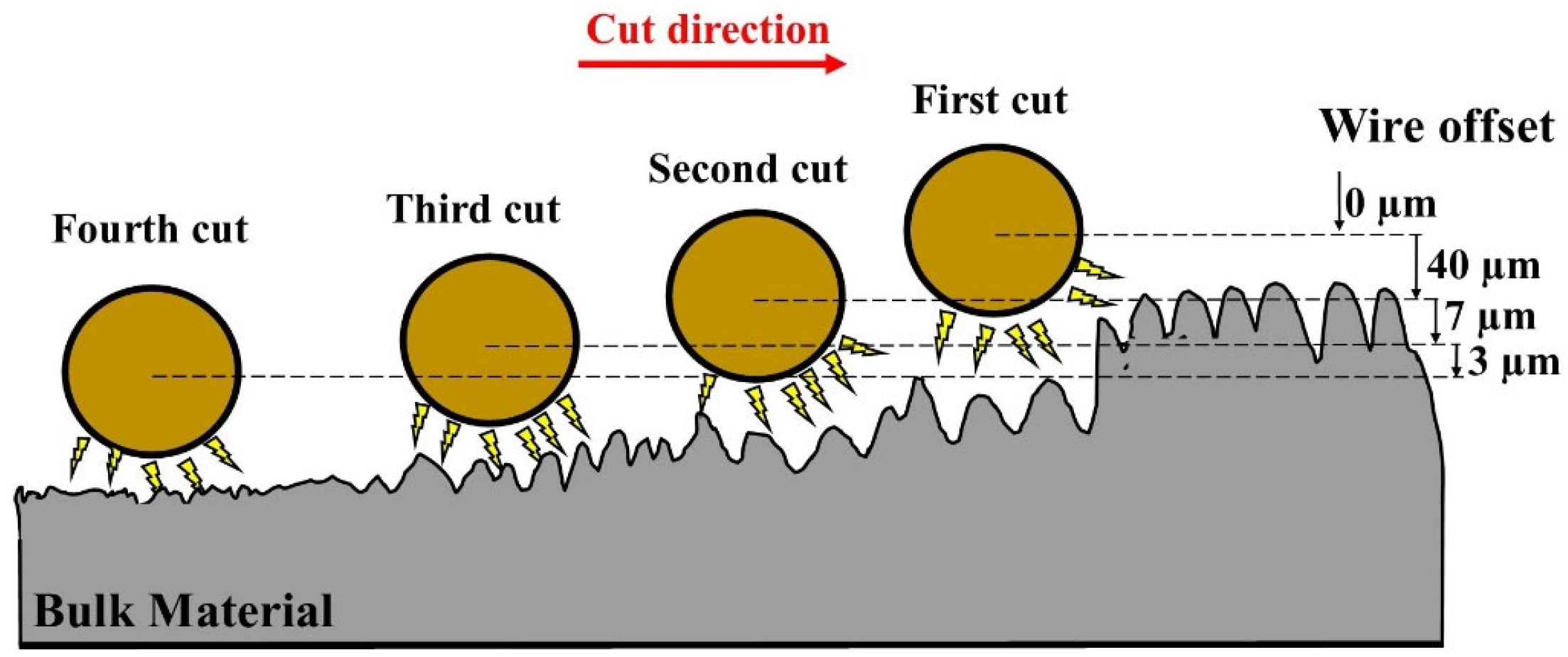

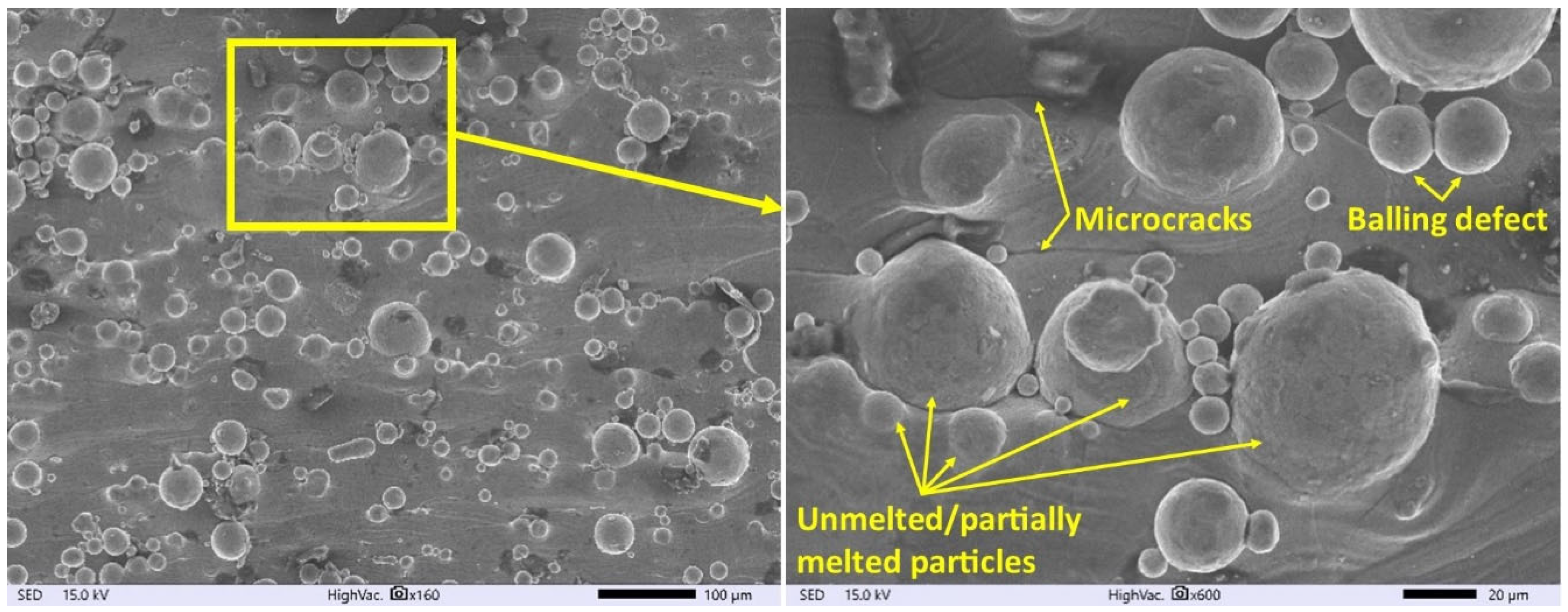

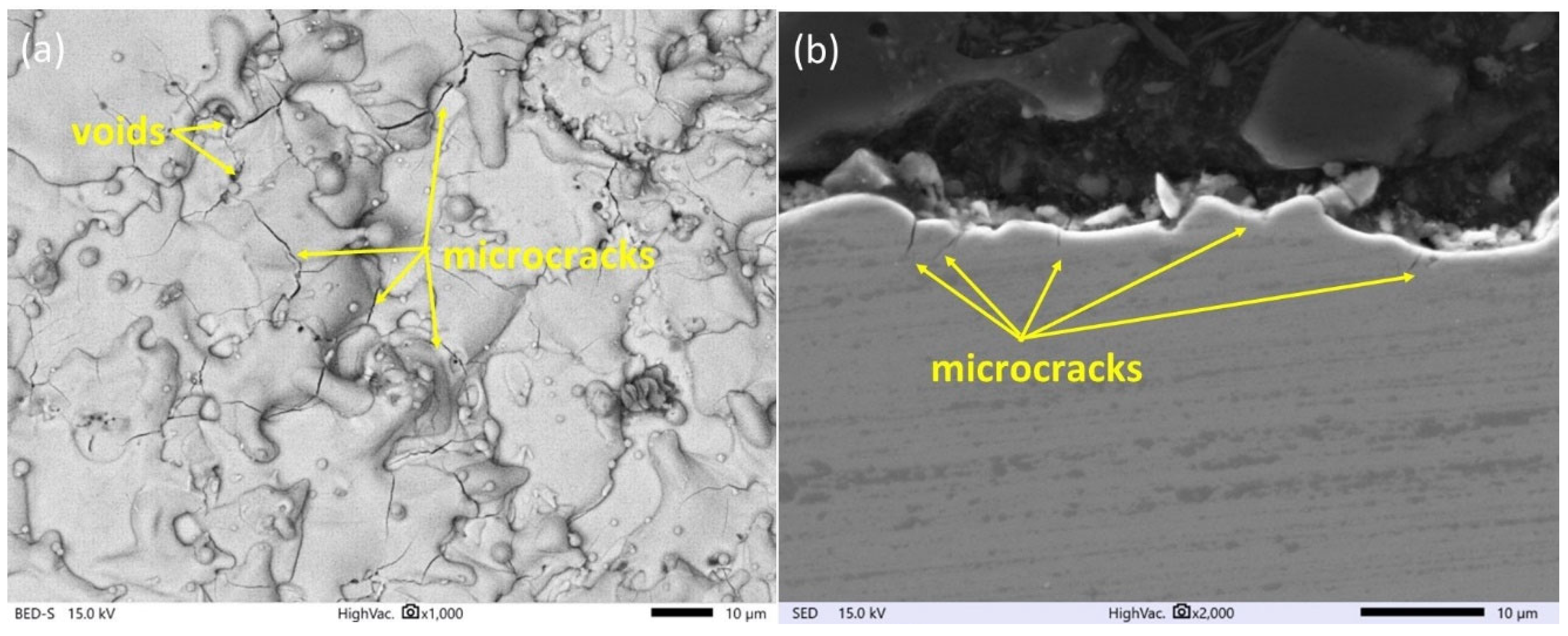



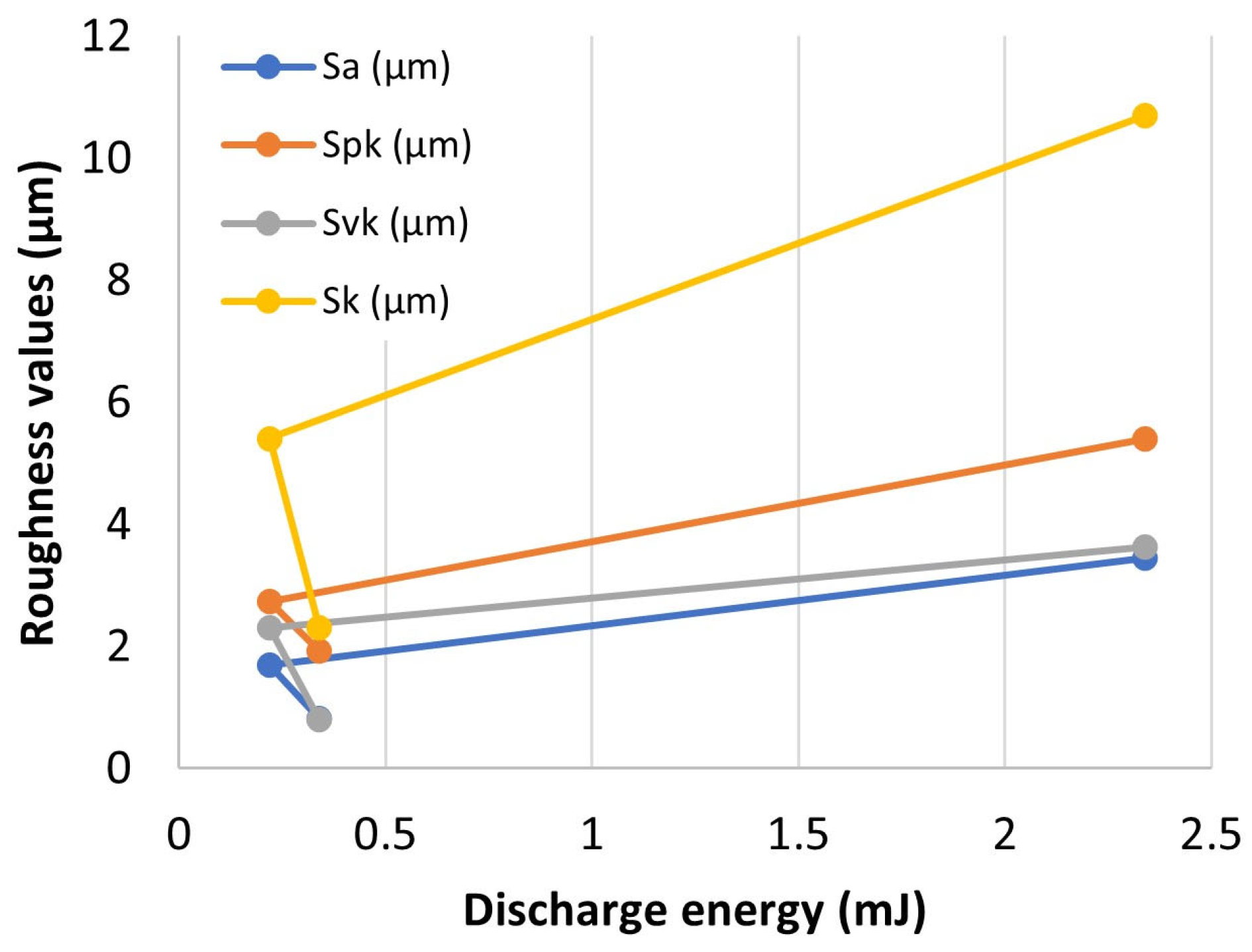
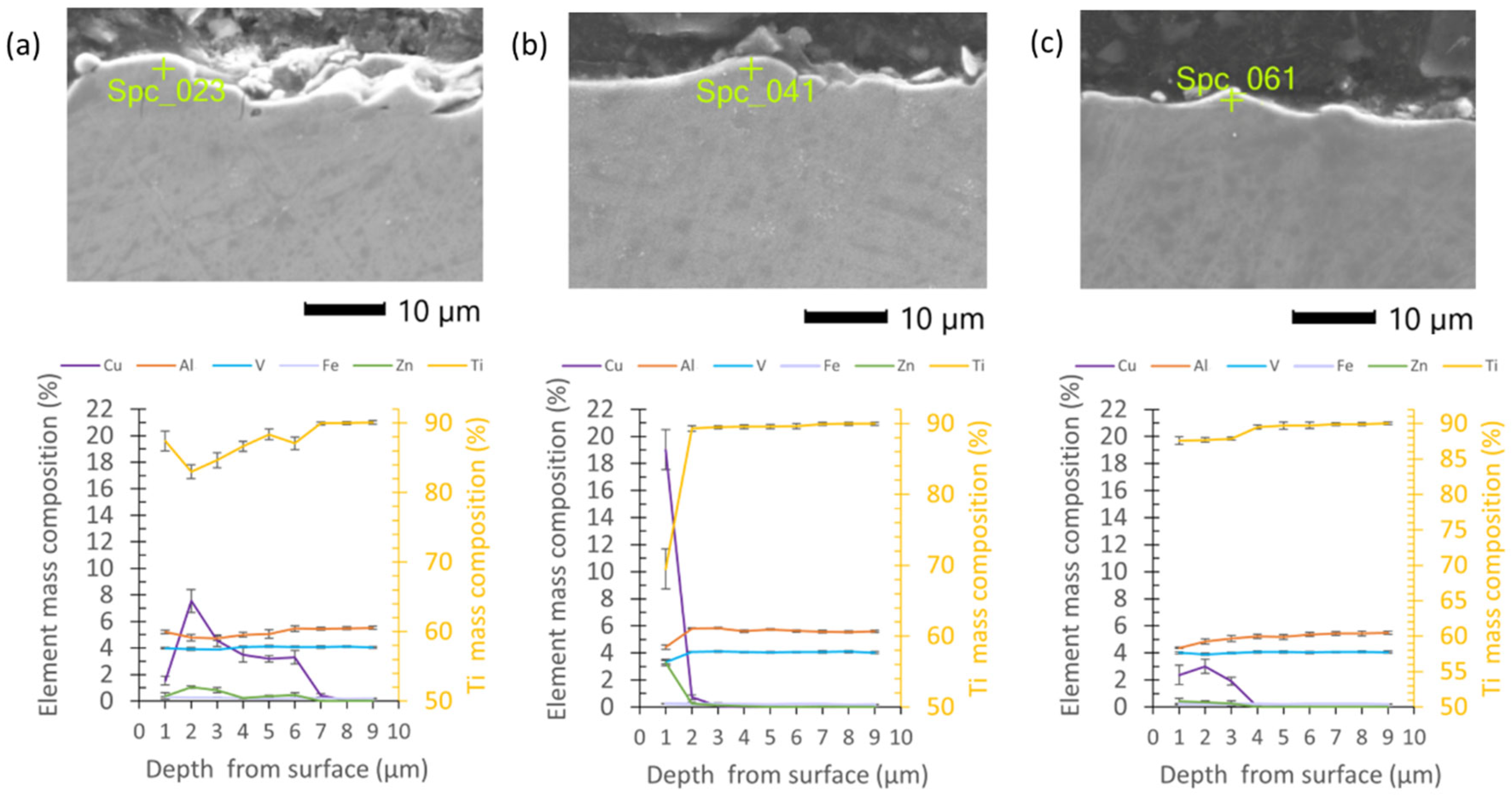


| SLM | Powder titanium particles | 20 μm to 40 μm |
| Laser power | 250 W | |
| Scanning speed | 400 mm/s | |
| Layer thickness | 30 μm | |
| Hatch spacing | 100 μm | |
| WEDM | Electrode | Hard brass wire, diameter 0.25 mm |
| Workpiece material | Ti6Al4V | |
| Discharge energy E | 0.21–1.46 mJ | |
| Time break toff | 3.6–18 μs | |
| Open voltage U0 | 220 V | |
| Dielectric | Deionized water |
| WEDM Cutting Mode | Wire Offset (µm) | Pulse Time (µs) | Discharge Voltage (V) | Time Break (µs) | Wire Speed (m/min) | |
|---|---|---|---|---|---|---|
| trim cut | 1-trim cut | 0 | 0.8 | −80 | 18 | 8 |
| three trim cuts | 1-trim cut | 0 | 0.8 | −80 | 18 | 8 |
| 2-trim cut | 40 | 0.4 | −80 | 3.6 | 8 | |
| 3-trim cut | 7 | 0.2 | −80 | 3.8 | 8 | |
| four trim cuts | 1-trim cut | 0 | 0.8 | −80 | 18 | 8 |
| 2-trim cut | 40 | 0.4 | −80 | 3.6 | 8 | |
| 3-trim cut | 7 | 0.2 | −80 | 3.8 | 8 | |
| 4-trim cut | 3 | 0.2 | 120 | 3.8 | 8 | |
| Roughness Parameters | SLM Sample | One Finishing WEDM Cut | Three Finishing WEDM Cuts | Four Finishing WEDM Cuts |
|---|---|---|---|---|
| Sa (µm) | 6.74 | 3.45 | 1.7 | 0.82 |
| Spk (µm) | 17.2 | 5.4 | 1.93 | 1.93 |
| Svk (µm) | 3.86 | 3.63 | 2.31 | 0.8 |
| Sk (µm) | 16.2 | 10.7 | 5.41 | 2.31 |
| SMr1 (%) | 19.4 | 12.5 | 9.09 | 14.9 |
| SMr2 (%) | 93 | 91.3 | 88 | 92.1 |
Disclaimer/Publisher’s Note: The statements, opinions and data contained in all publications are solely those of the individual author(s) and contributor(s) and not of MDPI and/or the editor(s). MDPI and/or the editor(s) disclaim responsibility for any injury to people or property resulting from any ideas, methods, instructions or products referred to in the content. |
© 2023 by the authors. Licensee MDPI, Basel, Switzerland. This article is an open access article distributed under the terms and conditions of the Creative Commons Attribution (CC BY) license (https://creativecommons.org/licenses/by/4.0/).
Share and Cite
Oniszczuk-Świercz, D.; Świercz, R. Effects of Wire Electrical Discharge Finishing Cuts on the Surface Integrity of Additively Manufactured Ti6Al4V Alloy. Materials 2023, 16, 5476. https://doi.org/10.3390/ma16155476
Oniszczuk-Świercz D, Świercz R. Effects of Wire Electrical Discharge Finishing Cuts on the Surface Integrity of Additively Manufactured Ti6Al4V Alloy. Materials. 2023; 16(15):5476. https://doi.org/10.3390/ma16155476
Chicago/Turabian StyleOniszczuk-Świercz, Dorota, and Rafał Świercz. 2023. "Effects of Wire Electrical Discharge Finishing Cuts on the Surface Integrity of Additively Manufactured Ti6Al4V Alloy" Materials 16, no. 15: 5476. https://doi.org/10.3390/ma16155476






